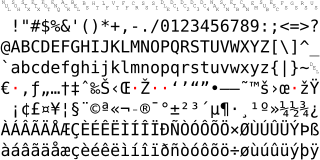Related Research Articles
UTF-8 is a variable-length character encoding standard used for electronic communication. Defined by the Unicode Standard, the name is derived from Unicode Transformation Format – 8-bit.

UTF-16 (16-bit Unicode Transformation Format) is a character encoding capable of encoding all 1,112,064 valid code points of Unicode (in fact this number of code points is dictated by the design of UTF-16). The encoding is variable-length, as code points are encoded with one or two 16-bit code units. UTF-16 arose from an earlier obsolete fixed-width 16-bit encoding now known as "UCS-2" (for 2-byte Universal Character Set), once it became clear that more than 216 (65,536) code points were needed, including most emoji and important CJK characters such as for personal and place names.

Microsoft Outlook is a personal information manager software system from Microsoft, available as a part of the Microsoft 365 software suites. Though primarily being popular as an email client for businesses, Outlook also includes functions such as calendaring, task managing, contact managing, note-taking, journal logging, web browsing, and RSS news aggregation.

Mojibake is the garbled or gibberish text that is the result of text being decoded using an unintended character encoding. The result is a systematic replacement of symbols with completely unrelated ones, often from a different writing system.

The Japanese era name or gengō (元号), is the first of the two elements that identify years in the Japanese era calendar scheme. The second element is a number which indicates the year number within the era, followed by the literal "nen (年)" meaning "year".
OpenType is a format for scalable computer fonts. Derived from TrueType, it retains TrueType's basic structure but adds many intricate data structures for describing typographic behavior. OpenType is a registered trademark of Microsoft Corporation.

Windows-1252 or CP-1252 is a legacy single-byte character encoding that is used by default in Microsoft Windows throughout the Americas, Western Europe, Oceania, and much of Africa.

GB 18030 is a Chinese government standard, described as Information Technology — Chinese coded character set and defines the required language and character support necessary for software in China. GB18030 is the registered Internet name for the official character set of the People's Republic of China (PRC) superseding GB2312. As a Unicode Transformation Format, GB18030 supports both simplified and traditional Chinese characters. It is also compatible with legacy encodings including GB/T 2312, CP936, and GBK 1.0.
Software versioning is the process of assigning either unique version names or unique version numbers to unique states of computer software. Within a given version number category, these numbers are generally assigned in increasing order and correspond to new developments in the software. At a fine-grained level, revision control is used for keeping track of incrementally-different versions of information, whether or not this information is computer software, in order to be able to roll any changes back.

Windows NT 3.1 is the first major release of the Windows NT operating system developed by Microsoft, released on July 27, 1993.
International Components for Unicode (ICU) is an open-source project of mature C/C++ and Java libraries for Unicode support, software internationalization, and software globalization. ICU is widely portable to many operating systems and environments. It gives applications the same results on all platforms and between C, C++, and Java software. The ICU project is a technical committee of the Unicode Consortium and sponsored, supported, and used by IBM and many other companies. ICU has been included as a standard component with Microsoft Windows since Windows 10 version 1703.
In Unicode, a Private Use Area (PUA) is a range of code points that, by definition, will not be assigned characters by the Unicode Consortium. Three private use areas are defined: one in the Basic Multilingual Plane, and one each in, and nearly covering, planes 15 and 16. The code points in these areas cannot be considered as standardized characters in Unicode itself. They are intentionally left undefined so that third parties may define their own characters without conflicting with Unicode Consortium assignments. Under the Unicode Stability Policy, the Private Use Areas will remain allocated for that purpose in all future Unicode versions.
The Microsoft Layer for Unicode (MSLU) is a software library for legacy versions of Windows, simplifying the creation of Unicode-aware programs on Windows 9x. It is also known as UnicoWS or by its filename, UNICOWS.DLL.

A crash reporter is usually a system software whose function is to identify reporting crash details and to alert when there are crashes, in production or on development / testing environments. Crash reports often include data such as stack traces, type of crash, trends and version of software. These reports help software developers- Web, SAAS, mobile apps and more, to diagnose and fix the underlying problem causing the crashes. Crash reports may contain sensitive information such as passwords, email addresses, and contact information, and so have become objects of interest for researchers in the field of computer security.

Liberation is the collective name of four TrueType font families: Liberation Sans, Liberation Sans Narrow, Liberation Serif, and Liberation Mono. These fonts are metrically compatible with the most popular fonts on the Microsoft Windows operating system and the Microsoft Office software package, for which Liberation is intended as a free substitute. The fonts are default in LibreOffice.
In computer science, data type limitations and software bugs can cause errors in time and date calculation or display. These are most commonly manifestations of arithmetic overflow, but can also be the result of other issues. The most well-known consequence of this type is the Y2K problem, but many other milestone dates or times exist that have caused or will cause problems depending on various programming deficiencies.

The year 2000 problem, or simply Y2K, refers to potential computer errors related to the formatting and storage of calendar data for dates in and after the year 2000. Many programs represented four-digit years with only the final two digits, making the year 2000 indistinguishable from 1900. Computer systems' inability to distinguish dates correctly had the potential to bring down worldwide infrastructures for computer reliant industries.
Enclosed CJK Letters and Months is a Unicode block containing circled and parenthesized Katakana, Hangul, and CJK ideographs. Also included in the block are miscellaneous glyphs that would more likely fit in CJK Compatibility or Enclosed Alphanumerics: a few unit abbreviations, circled numbers from 21 to 50, and circled multiples of 10 from 10 to 80 enclosed in black squares.
CJK Compatibility is a Unicode block containing square symbols encoded for compatibility with East Asian character sets. In Unicode 1.0, it was divided into two blocks, named CJK Squared Words (U+3300–U+337F) and CJK Squared Abbreviations (U+3380–U+33FF). The square forms can have different presentations when they are used in horizontal or vertical text. For example, the characters U+333E㌾SQUARE BORUTO and U+3327㌧SQUARE TON should look different in horizontal and in vertical right-to-left: ㌧㌾

Reiwa is the current and 232nd era of the official calendar of Japan. It began on 1 May 2019, the day on which Emperor Akihito's eldest son, Naruhito, ascended the throne as the 126th Emperor of Japan. The day before, Emperor Akihito abdicated the Chrysanthemum Throne, marking the end of the Heisei era. The year 2019 corresponds with Heisei 31 from 1 January to 30 April, and with Reiwa 1 from 1 May. The Ministry of Foreign Affairs of Japan explained the meaning of Reiwa to be "beautiful harmony".
References
- ↑ "Era Handling for the Japanese Calendar - Windows applications". docs.microsoft.com. Retrieved 2019-01-31.
- 1 2 kexugit (12 April 2018). "The Japanese Calendar's Y2K Moment". docs.microsoft.com. Retrieved 2021-12-11.
- ↑ Baseel, Casey (30 April 2019). "ATMs in Japan are saying they'll transfer your money back in time to 1989". SoraNews24. Retrieved 30 April 2019.
- ↑ "Summary of new Japanese era Windows updates - KB4469068". support.microsoft.com. Retrieved 2021-12-11.
- ↑ "Download macOS Mojave 10.14.5 Update". Apple Support. May 13, 2019. Archived from the original on October 15, 2023. Retrieved January 2, 2024.
- ↑ Peterson, Jake (April 9, 2019). "Apple Just Released iOS 12.3 Public Beta 2 for iPhone, Features Small Updates to Wallet & Date/Time". Gadget Hacks. Archived from the original on June 11, 2023. Retrieved January 2, 2024.
- ↑ "New Japanese Era" . Retrieved 2019-01-31.
- ↑ "Unicode 12.1.0" . Retrieved 2019-05-01.
- ↑ "22964 - The Japanese Era name will be changed on May 1, 2019" . Retrieved 2019-05-01.
- Hern, Alex (2018-07-25). "Big tech warns of 'Japan's millennium bug' ahead of Akihito's abdication". The Guardian. ISSN 0261-3077 . Retrieved 2019-01-31.
- "Japan's new Y2K: Chips with Everything podcast". The Guardian. 2019-01-04. ISSN 0261-3077 . Retrieved 2019-01-31.